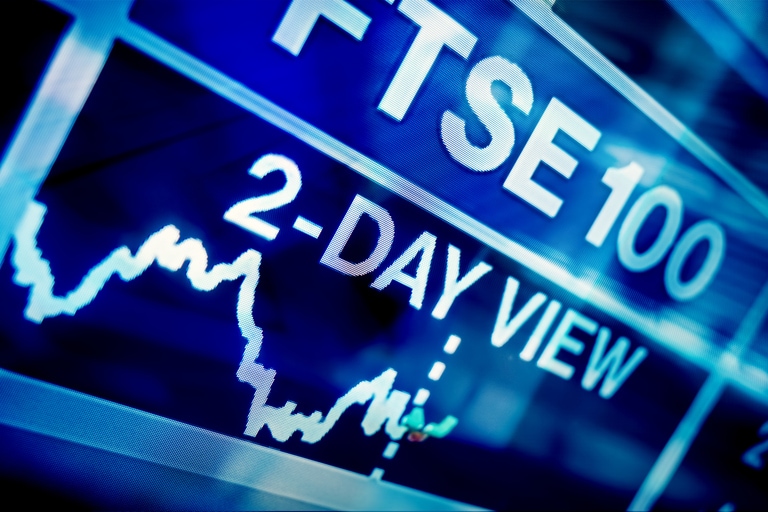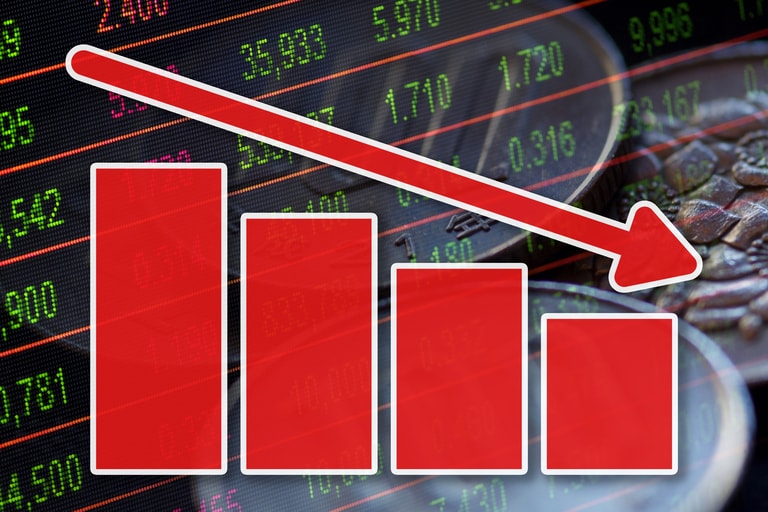Two headline economic events take place in the US this week, with the minutes from the Fed’s May meeting due to be published on Wednesday, and the surprise 1.4% contraction in US Q1 GDP set to be rubber-stamped on Thursday.
On the corporate front, Marks & Spencer reports its full-year results on Wednesday, while other companies issuing their latest numbers include Nvidia, Ted Baker, and B&Q owner Kingfisher.
OUR TOP THREE EVENTS FOR 23-27 MAY:
Wednesday – Fed minutes
As expected, the US Federal Reserve voted to increase the fed funds rate by 50 basis points at its meeting on 3-4 May, pushing the upper end of the target interest rate range to 1%. Talk of a possible 75 basis point move came to nothing, as the federal open market committee (FOMC) voted unanimously to raise rates by half a percentage point.
Fed chair Jay Powell dismissed the prospect of raising interest rates by more than 50 basis points in a single month, saying that “a 75 basis point increase is not something that the committee is actively considering”, although in subsequent comments he was careful not to rule it out entirely.
The central bank also announced plans to begin reducing its balance sheet, initially by $47.5bn a month from June, rising to $95bn a month from September. This gradual ramping up seems somewhat dovish, with policymakers shying away from starting the balance sheet reduction programme at $95bn a month. The publication of the May meeting minutes should shed more light on the conversation and thinking behind this decision.
The cautious approach to reducing the balance sheet suggests that there may be some anxiety over how the cuts will play out. Former president of the Richmond Fed, Jeffrey Lacker, recently said that the potential for further financial market volatility could force the Fed to choose between slowing the pace of runoffs and widening credit spreads to calm markets, or keeping policy tight to fight inflation.
Wednesday – Marks & Spencer full-year results
Since reaching a 21-month high of 263p on 10 January, the Marks & Spencer share price has halved in value. The retail sector faces challenges but investors may be overreacting, as M&S looks set to close out a decent year when it announces its full-year results on Wednesday. Its deal with Ocado has been central to the turnaround in its business. Earlier this year, when M&S reported results for the 13 weeks to 1 January, food sales were up 10% year-on-year. Meanwhile, clothing and home sales increased 3.2% on a two-year basis, as the inclusion of third-party brands like Fat Face and White Stuff helped improve online sales. This growth led M&S to raise its full-year pre-tax profit guidance to at least £500m.
Since then, the war in Ukraine has driven up costs for retailers. M&S chairman Archie Norman has warned that the price of food and clothing is likely to increase sharply in the coming months, due to higher freight, container and wages costs. M&S has faced criticism in recent weeks for not pulling out of Russia. Although M&S has stopped supplying stores in Russia, the retailer is unable to close its shops in the country because of franchise agreements. The use of the M&S name is owned by a Turkish company under a deal agreed in 1999, preventing M&S from making a complete exit.
In March CEO Steve Rowe announced that he would be stepping down, to be replaced on 25 May by COO and managing director of food Stuart Machin, who is also a director of Ocado Retail.
Thursday – US Q1 GDP
The world’s largest economy shrank 1.4% on an annualised basis in the first three months of the year, according to the first reading of US Q1 GDP. The second reading, due out on Thursday, is not expected to deliver any material change.
The surprise contraction in Q1 – markets had expected a 1% expansion – has raised concerns that the US economy could be heading towards stagflation and a possible recession, despite low unemployment. However, some observers have attempted to play down the contraction in Q1, citing slower inventory rebuilds in Q1 after the Christmas shopping period started earlier than usual in Q4 on fears of shortages and Covid disruptions. Many economists still expect the US economy to grow this year, dismissing Q1 as a blip.
Net trade subtracted 3.2% points from overall GDP, while inventories knocked off a further 0.8% points amid supply chain disruption. Personal consumption was resilient, however, with consumer and business spending up 3.7% annually, though this will face challenges in the months ahead as higher prices start to bite.
MORE KEY EVENTS (23-27 MAY):
Monday 23 May
Kingfisher Q1 results
UK retail stocks haven’t had a great start to the year, so it may come as no surprise that shares in B&Q and Screwfix owner Kingfisher are down more than a quarter year-to-date. Earlier this month the shares hit their lowest levels since July 2020 over concerns about the effect that rising costs and lower sales growth are likely to have on revenue and profits.
In March, Kingfisher reported record revenue and profits for its latest fiscal year. Statutory pre-tax profits were up 33.1% at just over £1bn, comfortably beating expectations of £950m, while sales rose 6.8% to £13.18bn. Despite various covid-related closures over the last 12 months, most areas of the business performed well, with operations in the UK, Ireland, and France all posting strong increases in profits. Kingfisher’s businesses in eastern Europe collectively saw profits decline by 5.8%, with Poland and Turkey particularly disappointing.
Although the results were positive overall, most of the heavy lifting on revenue and profits was done in Q1. When you look at the second half of the year, like-for-like sales declined in both Q3 and Q4. They are set to decline again in Q1, and it is this trend that has seen the shares decline sharply this year.
Expectations for Q1 are for revenue to decline 8.1% versus the high base of the year-ago period, which got a lockdown boost. On a two-year basis, the picture is expected to be better, with revenue set to rise 16%, driven by growth at Screwfix and in Poland.
Zoom Q1 results
Lockdown winner Zoom has seen its share price tumble 84% from the peak it reached in October 2020, the stock now back roughly where it was pre-pandemic. Revenue in the year to 31 January came in at $4.1bn, up 55% on the previous year. It was always going to be difficult to replicate the growth surge of the pandemic-era shift to remote working, but investors were still a little disappointed at the cautious guidance for the new fiscal year. Bosses said they expected to see full-year revenue of $4.53bn to $4.55bn, along with annual profits of $3.48 a share. Zoom’s biggest continues to be the fact that it is competing against the likes of Microsoft Teams and Skype. Q1 profits are expected to come in at $0.87 a share.
Tuesday 24 May
US core PCE deflator (April)
The Fed’s preferred measure of inflation, the core personal consumption expenditure (PCE) deflator, increased 5.2% in the 12 months to March, but is expected to have eased to 4.9% in the year to April as efforts to contain the inflation genie began to take effect.
Fresh from raising interest rates by 25 basis points in March, the US Federal Reserve followed up with a 50 basis-point hike in early May, promising another half-point move in June and further quarter-point rises later in the year. With the US consumer price index (CPI) rising 8.3% in the year to April, decelerating from 8.5% in March, there is optimism that inflation may be nearing its peak, though the jury remains out on that.
While headline CPI slowed in April, producer price growth remains more stubborn than Fed officials would like. One positive is that the strength of the US dollar is likely to act as an anchor on upward inflationary pressure, and could exert some downside pressure on headline inflation.
Germany, France flash PMIs (May)
Flash PMI numbers are rapidly losing credibility in terms of using the headline numbers to assess the state of the French, German and UK economies. Taking account of the wider economy, it is clear that economic growth is sluggish across the UK and continental Europe. However, looking at the purchasing managers’ index (PMI) numbers, it would be tempting to think that all is well. Common sense tells us that nothing could be further from the truth, with rising energy prices and supply chain disruptions posing significant challenges to businesses large and small.
PMI readings for manufacturing and services in May are expected to fall from the numbers we saw in April, when readings were in the mid-50s for all three of the UK, Germany and France.
Wednesday 25 May
Fed May meeting minutes
See top three events, above
Marks & Spencer full-year results
See top three events, above
Nvidia Q1 results
Six months ago Nvidia shares were trading at record highs, after a Q3 update reported that revenues and profits came in well ahead of expectations. The company also beat expectations on revenues and profits in Q4, but it would appear that the higher you set the bar, the more difficult it is to outperform. The company guided revenue of $8.1bn for Q1, $900m above consensus, which sent the shares sharply lower. The stock then got caught up in the big tech sell-off across the Nasdaq, contributing to a halving of the share price.
The past four quarters have brought significantly elevated revenue growth, and investors will be hoping that this week’s Q1 numbers make it five in a row. The decision to walk away from the ARM deal is expected to cost Nvidia $1.36bn, which, while disappointing, is probably a wise decision as it allows management to concentrate on fixing supply chain issues. Gaming is still Nvidia’s biggest earner, delivering revenue of $3.42bn in Q4, up 37% year-on-year. The data business is playing catch-up, with revenue up 71% at $3.26bn in Q4. For Q1, profits are expected to come in at $1.30 a share.
Snowflake Q1 results
The Nasdaq sell-off battered Snowflake’s shares, which have fallen more than 60% since the record highs of $404 in November last year. Though painful, this was a necessary readjustment of expectations for a company which posted annual revenue of $1.2bn and had a market cap of over $85bn at the end of last year. Annual revenues increased more than 100% versus a year earlier, but the cloud-computing company was never likely to be able to match that going forward. In Q4 revenue did beat expectations, coming in at $383.8m, resulting in a loss of $132m. Margins still look healthy, but costs rose sharply. While the business is expected to turn a profit on forecasts that annual revenue will rise to just over $2bn in the new fiscal year, it remains to be seen whether this will be enough to prevent further share price weakness. Q1 revenue is expected to rise 80% to around $385m, while losses are expected to come in at $0.01 a share.
Thursday 26 May
US Q1 GDP
See top three events, above
Ted Baker full-year results
Ted Baker shares have seen a decent uplift over the course of the past few weeks, mainly on the back of reports in March that New York-based Sycamore Partners was considering an offer for the business. It’s been a long, hard road for Ted Baker in recent years. At the most recent trading update, management indicated that progress was being made in turning around a business riven by scandal and stock accounting errors. The Q4 trading update showed that group sales were up 35% compared to a year ago, an acceleration from the 18% rise in Q3. Margins were also better, rising 350 basis points across all channels. Inventory levels improved, too, while sales in stores and online were showing signs of recovery, as volumes head back to pre-Covid levels.
The bid from Sycamore Partners, which valued Ted Baker at £254m, was ultimately rejected. However, the clothing company announced that they were launching a formal sale process. Whether the sale process leads to an offer remains to be seen, but the Ted Baker brand remains a solid one, despite all the recent problems. While the shares are cheap at around 140p, it would be a shame if the current management team’s hard work resulted in a cheap sale. Let’s not forget that in 2018 the shares were at £30, giving Ted Baker a market cap of £1.3bn.
Friday 27 May
No major announcements
Index dividend schedule
Dividend payments from an index's constituent shares can affect your trading account. View this week's index dividend schedule.
Selected company results
| MONDAY 23 MAY | RESULTS |
| Big Yellow Group (UK) | Full-year |
| Kainos (UK) | Full-year |
| Kingfisher (UK) | Q1 |
| Zoom Video Communications (US) | Q1 |
| TUESDAY 24 MAY | RESULTS |
| Abercrombie & Fitch (US) | Q1 |
| Bytes Technology (UK) | Full-year |
| Cranswick (UK) | Full-year |
| HomeServe (UK) | Full-year |
| Petco Health & Wellness (US) | Q1 |
| Ralph Lauren (US) | Q4 |
| Shaftesbury (UK) | Half-year |
| SSP Group (UK) | Half-year |
| Topps Tiles (UK) | Half-year |
| WEDNESDAY 25 MAY | RESULTS |
| Dick's Sporting Goods (US) | Q1 |
| DXC Technology (US) | Q4 |
| EnerSys (US) | Q4 |
| HICL Infrastructure (UK) | Full-year |
| Marks & Spencer (UK) | Full-year |
| Nvidia (US) | Q1 |
| Pets at Home (UK) | Full-year |
| Severn Trent (UK) | Full-year |
| Snowflake (US) | Q1 |
| Splunk (US) | Q1 |
| SSE (UK) | Full-year |
| Synairgen (UK) | Full-year |
| THURSDAY 26 MAY | RESULTS |
| AJ Bell (UK) | Half-year |
| Auto Trader (UK) | Full-year |
| Costco (US) | Q3 |
| Dollar General (US) | Q1 |
| Gap (US) | Q1 |
| Johnson Matthey (UK) | Full-year |
| Ted Baker (UK) | Full-year |
| Workday (US) | Q1 |
| FRIDAY 27 MAY | |
| No major announcements |
Company announcements are subject to change. All the events listed above were correct at the time of writing.
Disclaimer: CMC Markets is an execution-only service provider. The material (whether or not it states any opinions) is for general information purposes only, and does not take into account your personal circumstances or objectives. Nothing in this material is (or should be considered to be) financial, investment or other advice on which reliance should be placed. No opinion given in the material constitutes a recommendation by CMC Markets or the author that any particular investment, security, transaction or investment strategy is suitable for any specific person. The material has not been prepared in accordance with legal requirements designed to promote the independence of investment research. Although we are not specifically prevented from dealing before providing this material, we do not seek to take advantage of the material prior to its dissemination.







